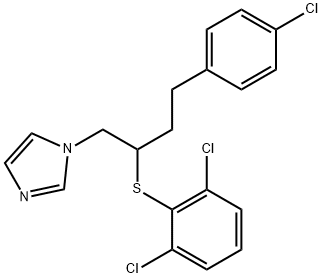CHEMICAL AND PHYSICAL PROPERTIES
| Physical Description | Solid |
|---|---|
| Melting Point | ~159°C with decomposition (nitrate salt) |
| Solubility | Nitrate salt: 0.26 mg/ml (practically insoluble) |
| LogP | 6.7 |
| Collision Cross Section | 186.5 Ų [M+H]+ [CCS Type: TW, Method: calibrated with polyalanine and drug standards] |
COMPUTED DESCRIPTORS
| Molecular Weight | 411.8 g/mol |
|---|---|
| XLogP3 | 6.4 |
| Hydrogen Bond Donor Count | 0 |
| Hydrogen Bond Acceptor Count | 2 |
| Rotatable Bond Count | 7 |
| Exact Mass | 410.017803 g/mol |
| Monoisotopic Mass | 410.017803 g/mol |
| Topological Polar Surface Area | 43.1 Ų |
| Heavy Atom Count | 25 |
| Formal Charge | 0 |
| Complexity | 383 |
| Isotope Atom Count | 0 |
| Defined Atom Stereocenter Count | 0 |
| Undefined Atom Stereocenter Count | 1 |
| Defined Bond Stereocenter Count | 0 |
| Undefined Bond Stereocenter Count | 0 |
| Covalently-Bonded Unit Count | 1 |
| Compound Is Canonicalized | Yes |
PRODUCT INTRODUCTION
description
Butoconazole is a member of the class of imidazoles that is 1H-imidazole in which the hydrogen attached to the nitrogen is substituted by a 4-(4-chlorophenyl)-2-[(2,6-dichlorophenyl)sulfanyl]butyl group. An antifungal agent, it is used as its nitrate salt in gynaecology for treatment of vulvovaginal infections caused by Candida species, particularly Candida albicans. It is a member of imidazoles, an aryl sulfide, a dichlorobenzene, a member of monochlorobenzenes, an imidazole antifungal drug and a conazole antifungal drug. It is a conjugate base of a butoconazole(1+).

